
The Treaty of Cahuenga, also called the Capitulation of Cahuenga, was an 1847 agreement that ended the Conquest of California, resulting in a ceasefire between Californios and Americans. The treaty was signed at the Campo de Cahuenga on 13 January 1847, ending the fighting of the Mexican-American War within Alta California. The treaty was drafted in both English and Spanish by José Antonio Carrillo and signed by John C. Frémont, representing the American forces, and Andrés Pico, representing the Mexican forces.
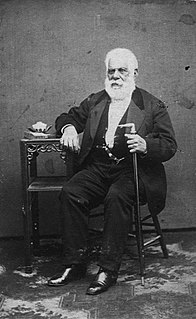
Don Pío de Jesús Pico was a Californio politician, ranchero, and entrepreneur, famous for serving as the last Governor of Alta California under Mexican rule. A member of the prominent Pico family of California, he was one of the wealthiest men in California at the time and a hugely influential figure in Californian society. His legacy can be seen in the numerous places named after him, such as the city of Pico Rivera, Pico Boulevard in Los Angeles, Pio Pico State Historic Park, and the numerous schools that bear his name.

Stephen Watts Kearny ; was one of the foremost antebellum frontier officers of the United States Army. He is remembered for his significant contributions in the Mexican–American War, especially the conquest of California. The Kearny code, proclaimed on September 22, 1846, in Santa Fe, established the law and government of the newly acquired territory of New Mexico and was named after him. His nephew was Major General Philip Kearny of American Civil War fame.

Californios are Hispanic people native to the U.S. state of California. California's Spanish-speaking community has resided there since 1683 and is made up of varying Spanish, Mestizo, and Indigenous Californian origins. Alongside the Tejanos of Texas and Neomexicanos of New Mexico and Colorado, Californios are part of the larger Chicano/Mexican-American/Hispano community of the United States, which has inhabited the American Southwest and the West Coast since the 16th century.

The Battle of La Mesa was the final battle of the California Campaign during the Mexican–American War, occurring on January 9, 1847, in present-day Vernon, California, the day after the Battle of Rio San Gabriel. The battle was a victory for the United States Army under Commodore Robert F. Stockton and General Stephen Watts Kearny.

The Santa Margarita de Cortona Asistencia was established in 1787 as an asistencia ("sub-mission") to Mission San Luis Obispo de Tolosa, then in the Spanish Las Californias Province. Its site is near the present day city of Santa Margarita, in San Luis Obispo County, central California.

The Stagecoach Inn Museum in Newbury Park, California, originally known as the Grand Union Hotel, was used as a resting area for people who traveled from Los Angeles to Santa Barbara. Besides a hotel and stagecoach stop, it has also been used as a post office, church, restaurant and military school. It is California Historical Landmark No. 659 and is listed in the National Register of Historic Places. It played a major role in the development of the stage line transportation network in California. The hotel was also the first business venture in the Conejo Valley.

Andrés Pico was a Californio who became a successful rancher, fought in the contested Battle of San Pascual during the Mexican–American War, and negotiated promises of post-war protections for Californios in the 1847 Treaty of Cahuenga. After California became one of the United States, Pico was elected to the state Assembly and Senate. He was appointed as the commanding brigadier general of the state militia during the U.S. Civil War.

El Presidio Real de Santa Bárbara, also known as the Royal Presidio of Santa Barbara, is a former military installation in Santa Barbara, California, United States. The presidio was built by Spain in 1782, with the mission of defending the Second Military District in California. In modern times, the Presidio serves as a significant tourist attraction, museum and an active archaeological site as part of El Presidio de Santa Barbara State Historic Park.
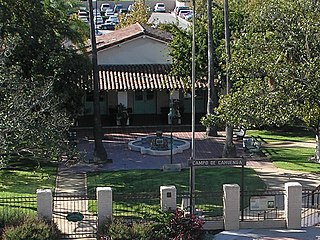
The Campo de Cahuenga, near the historic Cahuenga Pass in present-day Studio City, California, was an adobe ranch house on the Rancho Cahuenga where the Treaty of Cahuenga was signed between Lieutenant Colonel John C. Frémont and General Andrés Pico in 1847, ending hostilities in California between Mexico and the United States. The subsequent Treaty of Guadalupe Hidalgo of 1848, ceding California, parts of Colorado, Nevada, New Mexico, and Arizona to the United States, formally ended the Mexican–American War. From 1858 to 1861 the Campo de Cahuenga became a Butterfield Stage Station.

San Marcos Pass is a mountain pass in the Santa Ynez Mountains in southern California.

The Battle of the Natividad took place on November 16, 1846, in the Salinas Valley, in present-day Monterey County, California, United States, during the California Campaign of the Mexican–American War, between United States organized California militia and loyalist Mexican militia.

Captain José Antonio Ezequiel Carrillo (1796–1862) was a Californio politician, ranchero, and signer of the Californian Constitution in 1849. He served three terms as Alcalde of Los Angeles (mayor).

The history of the San Fernando Valley from its exploration by the 1769 Portola expedition to the annexation of much of it by the City of Los Angeles in 1915 is a story of booms and busts, as cattle ranching, sheep ranching, large-scale wheat farming, and fruit orchards flourished and faded. Throughout its history, settlement in the San Fernando Valley was shaped by availability of reliable water supplies and by proximity to the major transportation routes through the surrounding mountains.

The Conquest of California, also known as the Conquest of Alta California or the California Campaign, was an important military campaign of the Mexican–American War carried out by the United States in Alta California, then a part of Mexico. The conquest lasted from 1846 into 1847, until military leaders from both the Californios and Americans signed the Treaty of Cahuenga, which ended the conflict in California.
Bernarda Ruiz De Rodriguez was a native Californio who may have had a hand in brokering the Treaty of Cahuenga between American Lieutenant-Colonel John C. Frémont and Mexican General Andrés Pico on January 13, 1847 at Campo de Cahuenga in what is now Universal City, Los Angeles, California.
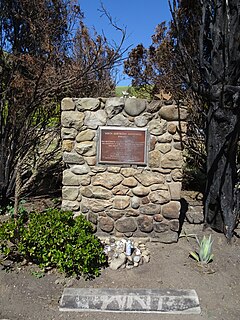
The Santa Gertrudis Asistencia, also known as the Santa Gertrudis Chapel, was an asistencia ("sub-mission") to the Mission San Buenaventura, part of the system of Spanish missions in Las Californias—Alta California. Built at an unknown date between 1792 and 1809, it was located approximately five miles from the main mission, inland and upstream along the Ventura River. The site was buried in 1968 by the construction of California State Route 33. Prior to the freeway's construction, archaeologists excavated and studied the site. A number of foundation stones were moved and used to create the Santa Gertrudis Asistencia Monument which was designated in 1970 as Ventura County Historic Landmark No. 11.
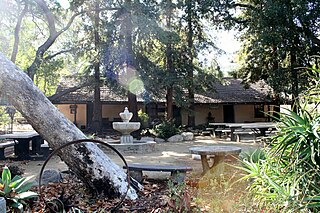
The Catalina Verdugo Adobe, also known as the Catalina Adobe, the Verdugo Adobe, and the Teodoro Adobe, is a historic adobe building and a public park located at 2211 Bonita Drive in Glendale, California.
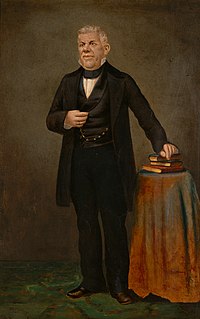
The Pico family is a prominent Californio family of Southern California. Members of the family held extensive rancho grants and numerous important positions, including Governor of Alta California, signer of the Constitution of California, and California State Senator, among numerous others. Numerous locations are named after the family across California.




















